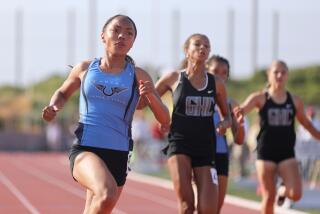Running Into Danger in Streets
- Share via
AMHERST, N.Y. — By all accounts, Tim Butler was a bright and rising star, every parent’s dream. In an instant, a car hit and killed the high school runner and he became a stark reminder of the dangers faced by athletes like him.
Tim was struck one afternoon in January while practicing with Amherst Central High School’s indoor track team. His ankle sore, he was trying to cross a busy road as he and a teammate returned to school.
His death led school officials to rethink sending distance runners to the streets and opened a safety discussion reaching far beyond this Buffalo suburb.
There is plenty to cause concern, especially in winter: Off-road tracks and trails used in warmer months are snow- and ice-covered and unusable, and clogged sidewalks force pedestrians and runners into streets narrowed by snowdrifts. Nightfall comes earlier -- during the evening rush hour when after-school teams hit their stride. Early sunsets and high snowbanks make visibility poor for drivers.
But there are few alternatives, coaches say.
“To be a good distance runner, you have to log the miles,” said Gary Parker, track chairman of the National High School Athletic Coaches Assn.
Tim, a 15-year-old sophomore honors student, was jogging in place on the shoulder of the road, waiting to cross. His teammate told police that he saw a car approaching and told Tim to wait.
Tim “apparently didn’t hear or he didn’t heed,” Amherst Police Chief Ronald Hagelberger said. “Who knows? We’ll never know.”
He was pronounced dead at the hospital 45 minutes later.
The driver was not charged, but police ticketed him for having bald tires and inadequate brakes.
The school is now considering alternatives to having students run in the streets, including busing runners to parks or other safer places.
At Parker’s school in Blue Springs, Mo., and in some surrounding communities, parents sign a waiver acknowledging dangers, although they are assured that safety is a priority.
“It is dangerous. Drunk drivers, anything can happen,” Parker said, and told of a coach struck by a car and hospitalized for two months.
John McGinnis, an Oklahoma high school principal who coached track for 19 years, said his teams practice before school, at 5:30 a.m., when traffic is light.
“I would question running at that time of night,” he said of the Amherst accident. “It’s when you have the most traffic, people are coming home -- and you’re dealing with 14- to 17-, 18-year-old kids who, when they’re running, if they’re tired, they might not make good decisions.”
Widespread safety practices include wearing blaze-orange vests (Tim Butler was not wearing one), running single file and facing traffic, running in groups and staying off busy roads whenever possible.
In Buffalo and other school districts, runners are taken to parks and prohibited from running in the streets.
Despite coaches’ best efforts, McGinnis said he has seen runners bumped by cars or pelted with objects tossed by drivers or passengers.
Clarence High School runners are told to take all the usual precautions, athletic director Greg Kaszubski said. Since the accident in neighboring Amherst, groups take two-way radios for emergency situations.
Even so, Kaszubski said he still receives a couple of calls a season from drivers complaining about track members running two or three abreast.
Candice Cambio of Clarence said she cringes when she sees runners fall out of the single-file formation.
“It makes me nervous, especially when you see them at the last minute and you wonder if the car behind you is going to see them,” she said.
Runner Ariana Smaczniak, 15, acknowledged that there were times when the single-file rule was viewed as optional, but since Tim’s death “on the busy roads, now you definitely run one-by-one.”
It jolted parents to seek safety assurances from their children.
“My parents don’t want me running on the roads any more,” said Devin Lulek, 15, a Clarence sophomore. “But I told them that we wear jog [vests] and take every safety precaution we can, so they’re OK with it now.”
Ariana’s mother, Karen Smaczniak, said she doesn’t like the idea of her daughter running on busy roads but puts her faith in the coaches and in the athletes exercising a little common sense.
“I think that the coaches are pretty good about making sure that they do follow safety rules,” she said. “But whether or not the kids abide by them is, of course, another story. I have no clue; I’m not with them.
“I’m just hoping they’re using the common sense that God gave them,” she said.
The National Highway Traffic Safety Administration, which keeps track of pedestrian deaths, does not differentiate between those walking or running. In 2001, 4,882 pedestrians were killed by cars, 511 of them between the ages of 10 and 20.
More to Read
Sign up for Essential California
The most important California stories and recommendations in your inbox every morning.
You may occasionally receive promotional content from the Los Angeles Times.












